4 The Role of Virtual Design and Construction (VDC) in Helping Mitigate Rework in MEP Coordination Among Stakeholders at SeaTac Concourse C Expansion Project
Chanhan "Andy" Lee, P.E.
Case Study Author: Lieutenant Commander Chanhan “Andy” Lee, P.E. CEC, USN
Case Study Title: The Role of Virtual Design and Construction (VDC) in Helping Mitigate Rework in MEP Coordination Among Stakeholders at SeaTac Concourse C Expansion Project
Case Study Project Location: Seattle-Tacoma International Airport Concourse C
Case Study Points of Contact: A. K. (VDC Manager) and D. C. (VDC Manager) at Turner Construction Company
Case Study Team Members: Turner Construction Company VDC Lead, Trade Partners VDC Leads, Owner (Port of Seattle)
Case Study Project Value and Delivery Method: $399 Million GC/CM
Case Study Audiences: Professor Carrie Sturts Dossick, Ph.D., P.E. University of Washington & The United States Navy Naval Facilities Engineering Systems Command (NAVFAC)
1. BACKGROUND
In October 2023, Turner Construction Company was chosen as the general contractor to lead efforts to expand Concourse C at Seattle-Tacoma International Airport (SEA). The project, valued at $399 million, aims to add 146,000 square feet of space to the concourse, which houses the majority of operations for Alaska Airlines. Port of Seattle, the owner, aims to bring much-needed upgrades to the airport facilities, while adding more amenity options such as dining, retail, meditation room and a new airline lounge. Turner, as the GC/CM, has partnered with several key subcontractors and trade partners including the mechanical, electrical, and plumbing (MEP) throughout the duration of the contract and has been conducting a virtual weekly MEP coordination meeting with all of the major stakeholders, in which Turner’s Virtual Design and Construction (VDC) team demonstrates and shares the digital twin (DT) model of the new concourse. The purpose being to ensure viewers can accurately visualize the details of all construction line items such as the HVAC, electrical wiring, water pipes, fire suppression system, door system, and etc.
As a part of the University of Washington Master’s Program, the CM 515 class offered an unique opportunity for me to dive deeper into how the new VDC technology has facilitated MEP coordination through utilization of the DT model. I was given a chance to speak to several points of contact within Turner Construction Company through some networking opportunities, including those listed above, as well as to participate and observe in several iterations of the MEP coordination meetings held virtually every Tuesday.
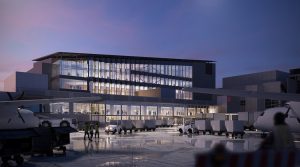
Rendering of the Concourse C Expansion Project at SeaTac [1]
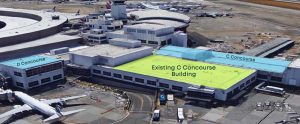
Diagram showing the exact location of the Concourse C Expansion [2]
2. MOTIVATION FOR THIS CASE STUDY
- Re-Visualization through Building Information Modeling (BIM) – Re-Visualization through Building Information Modeling (BIM) – Over the course of history, construction coordination has evolved from rudimentary 3D model replicas to the prevalent use of 2D paper design sheets as projects grew in complexity. However, recognizing that humans are natural visual learners, an increasing number of construction firms are reverting to 3D visualization of their projects with the aid of technology, thereby streamlining conflict resolution among key stakeholders. BIM, conceptualized in 1962 and continuing to evolve today, aims to reintroduce the possibility of visualizing models in 3D, essentially enabling stakeholders to virtually ‘see the building.’ This shift is pivotal in modern project management, allowing for enhanced comprehension and collaboration [3].
- Management through Virtual Design Construction (VDC) – Management through Virtual Design Construction (VDC) – While BIM lays the groundwork for visualizing projects, Virtual Design Construction (VDC) takes it a step further by enabling the management of integrated multi-disciplinary performance models. VDC encompasses various aspects, including facilities, work processes, and the organization of key stakeholders, all vital for supporting complex construction endeavors[4]. Turner Construction Company in Seattle has embraced this technology, leveraging an internal workforce to facilitate coordination across disciplines via VDC model cloud, utilizing digital twin (DT) technology to demonstrate intricate details and identify potential conflicts.
- Mitigation of Rework during Construction Phase – Traditional construction practices often lead to coordination conflicts, clashes, and errors, resulting in costly rework during the construction phase. Rework in MEP systems, stemming from these practices, significantly impacts project timelines, budgets, and overall efficiency. Recognizing these challenges, there is a growing need for innovative solutions like Virtual Design and Construction (VDC) to mitigate rework and enhance project outcomes. My firsthand experience at Turner Construction Company’s MEP Coordination meeting vividly demonstrated how effectively crucial details could be communicated, empowering each representative to address issues promptly, thereby mitigating rework.
3. DEFINITIONS/TERMS
- Reality Capture Technologies – Turner Construction Company uses the Open Space application to record project progress and make it available to everyone. Turner also uses terrestrial laser scanners to create and use a point cloud in several ways including but not limited to modeling existing content, coordination, etc. Open Space utilizes computer vision in order to interpret and understand digital images and videos, 3D reconstruction to locate features in space and recreate 3D environments, machine learning to create a mathematical model based on training data to predict future results, and Simultaneous Location and Mapping (SLAM) to construct a map of an unknown environment while simultaneously moving through it. [5]
- MEP/BIM Coordination – Turner Construction Company also uses the Autodesk Construction Cloud to manage/document its coordination efforts. The VDC Engineers in Turner use Navisworks to consolidate all the models and run clash detections. Such marriage of MEP coordination in BIM “allows for improved coordination between all stakeholders involved in a project.” [6]
- BIM Execution Plan – Turner Construction Company, prior to starting a project, customizes a project-specific BIM Execution Plan (BEP), tailored to the project, the owner/trade partner it works with. In this plan, the company lays out several key functions, including (but not limited to) roles and responsibilities, levels of details, 3D model management hierarchy, mark-ups, and clashes resolvances. Having a good BEP is the key to the successful for “any construction project using BIM” and “generally accepted as a means of implementing BIM.” [7]
- Digital Twin – A Digital Twin (DT) is a “dynamic digital representation, virtual replica of a physical asset or system that continuously receives and integrates real-time data from sensors, Internet of Things (IoT) devices, and other sources.”[8] All of Turner’s trade partners are required to generate an as-built 3D model of their scope that captures all the changes/updates throughout construction. These models can be combined into an as-built consolidated model also called as digital twins, and can be used by the owner/facility manager teams during the project life cycle even after construction completion.
- Prefabrication – The prefabrication of all construction materials, due to the utilization of BIM and the coordination effort through Digital Twins, is made possible, thus saving time and money.
4. PURPOSE
I advocate for the utilization of VDC-related technologies, as outlined in the definitions provided, within the SeaTac Concourse C Expansion Project. These technologies offer key advantages in mitigating MEP coordination rework by firstly reinstating a 3D visualization of the project, facilitating the demonstration of intricate details. Secondly, they employ technology to proactively address conflicts within the system. These benefits result in significant time and cost savings by addressing conflicts early in the process, prior to installation, and fostering collaborative efforts among stakeholders through clear visualization via digital twins (DT). The purpose of this case study is to underscore these advantages to NAVFAC Headquarters, encouraging the adoption of such technologies to aid project and design managers in achieving expedited solutions for MILCON program designs. Through an examination of VDC tools and processes, this study aims to:
- assess the impact of VDC on reducing coordination clashes and conflicts in MEP systems,
- evaluate stakeholder perceptions and experiences regarding the integration of VDC into the project workflow, and
- identify best practices and lessons learned for future projects in the construction industry.
5. FOCUS
I have interacted primarily with the VDC representatives from the Turner Construction Company, as well as virtually through MEP coordination meetings with the owner and representatives from the key trade partners (i.e. HVAC, fire protection, electrical, plumbing, and others) in order to evaluate how they feel about working with the VDC Cloud Model of the project and how they feel it has helped with streamlining the MEP coordination process.
6. DATA COLLECTED
The data collection process involves multiple stages and methodologies:
- Document Analysis: Reviewing limited project documents, including construction drawings, MEP coordination reports, and project schedules, in order to understand historical trends and identify rework instances.
- Stakeholder Interviews: Conducting structured interviews with key project stakeholders, including project managers, architects, engineers, contractors, and subcontractors, to gather insights into their experiences with VDC implementation, challenges faced, and perceived benefits.
- Observations/Job Site Visits: Observing VDC implementation sessions, coordination meetings, and construction site activities to understand how VDC is integrated into the project workflow and its impact on reducing rework.
7. QUALITATIVE & QUANTITATIVE PATTERNS
Through the data collected so far, I have noticed several major trends when utilizing the VDC technology within MEP coordination at the Seattle-Tacoma International Airport Concourse C.
- Utilization of BIM/Digital Twins
- BIM (Building Information Modeling) and Digital Twins are extensively utilized in the Turner Construction Company’s Western US region of operation, including the SeaTac project, for MEP (Mechanical, Electrical, Plumbing) coordination.
- According to A.K. (VDC Engineer at Turner), approximately 80% of trade partners that Turner collaborates with in the Pacific Northwest Area are using 3D modeling for MEP coordination, primarily driven by the benefits of logistics planning and prefabrication.
- According to A.K. (VDC Engineer at Turner), adoption of 3D modeling by smaller trade partners is expected to increase, especially for commercial projects, due to industry trends.
- According to D.C. (VDC Engineer at Turner), other than MEP Coordination, Turner Construction Company utilizes the BIM in various uses, such as concrete design, pre-fabrication of different aspects of the construction, collaboration with the marketing team, and demonstrating the different phases of construction as shown in the figure below.
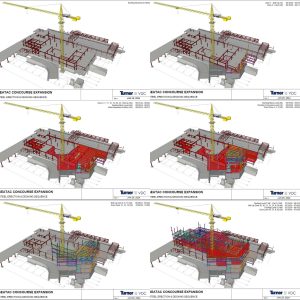
- BIM Execution Plan and Navisworks
- Turner Construction has implemented a comprehensive BIM Execution Plan, outlining roles, responsibilities, model updating procedures, clash resolution, and other rules. The following link is an example of Turner Construction Company’s BIM Execution Plan for the Great Wolf Lodge at Garden Grove, CA back in 2013. Turner BIM Execution Plan Example
- Navisworks is used for model coordination and sharing due to its compatibility with various Autodesk software used by trade partners. Turner utilizes this software in order to consolidate the model and run batches of clashes between the trades. There have been no significant issues reported in following the BIM Execution Document, indicating its effectiveness and standardization across the region.
- Cost Savings
- Adoption of BIM technology has led to significant cost savings, with an estimated $1,500 saved per Request for Information (RFI) eliminated, totaling potentially $150,000 in savings for 100 RFIs. The primary goal is to achieve smoother processes, better quality, and reduced rework, benefiting both Turner Construction and trade partners.
- During 12 hours of observing three MEP coordination meetings, approximately 30 potential conflicts were openly discussed, with about half resolved immediately and the rest deferred for further review. This rapid resolution contrasts sharply with traditional meetings lacking visual aids like digital twins, where stakeholders must individually review 2D drawings and formally document conflicts, often leading to time-consuming processes and incomplete error detection.
- Communication and Collaboration
- BIM technology fosters informal communication and collaboration among stakeholders, leading to faster issue resolution and greater involvement from various trades.
- The process builds connections among project participants and encourages input from multiple stakeholders, enhancing overall communication and project outcomes.
- While structured similarly to standard quality control meetings with NAVFAC, these MEP coordination meetings fostered more open communication among major stakeholders, prioritizing proactive solutions over reactive approaches. All construction project members, including owners and customers like the Transport Security Administration, actively participated, contributing concerns, ideas, and solutions. The inclusion of visual models instilled a positive attitude and ensured alignment among participants.
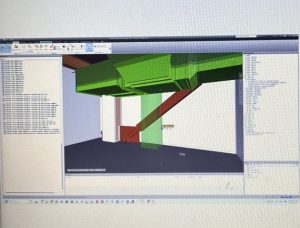
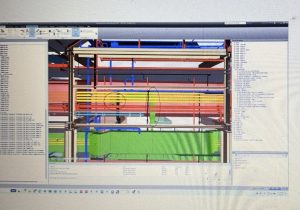
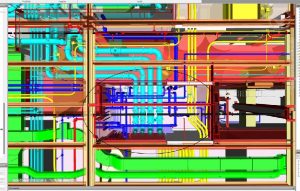
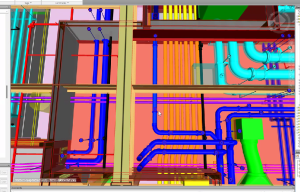
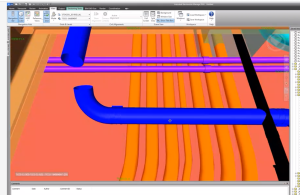
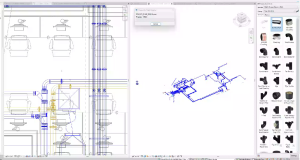
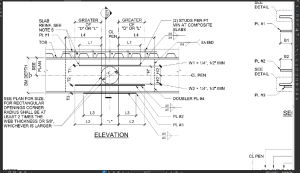
8. INTO THE BIGGER PICTURE
As outlined in the ‘purpose’, my objective is to underscore the benefits of implementing VDC technologies to the US Naval Facilities Engineering Systems Command (NAVFAC), aiming to encourage its adoption within the organization. While the direct quantifiable benefits of this case study may be limited, the positive qualitative trends identified, coupled with NAVFAC’s shifting stance towards embracing innovative project delivery systems like Design-Build over traditional Design-Bid-Build approaches, have the potential to catalyze further enthusiasm for organizational change.
9. CASE STUDY LIMITATIONS
Due to the limited duration of the case study, spanning only one quarter, my participation was primarily virtual, engaging in MEP coordination meetings online. I had the opportunity to speak with two personnel members from Turner Construction Company and conducted a single interview. However, logistical constraints prevented me from conducting a site visit and establishing connections with trade partners and project owners. Furthermore, ongoing project status restricted access to certain information, some of which required redaction due to sensitivity concerns.
10. FUTURE RESEARCH RECOMMENDATIONS
Challenges in the VDC still remain, as mentioned to me by A.K. during the interview. These include scanning existing facilities, determining systems for demolition, and outsourcing modeling of existing MEP systems to save costs. Based on the A.K.’s concerns and my observation during the past 5 weeks of being involved in this case study, here are some future research recommendations:
- Enhanced Facility Scanning Techniques: Investigate advanced scanning techniques, such as LiDAR or photogrammetry, to improve the accuracy and efficiency of capturing existing facility conditions. Research should focus on optimizing scanning parameters, data processing algorithms, and integration with VDC software to streamline the generation of digital twin models.
- Integration of Demolition Planning Tools: Develop specialized tools or modules within VDC software platforms to support the planning and visualization of demolition activities. This may include features for identifying and tracking systems slated for demolition, simulating demolition sequences, and assessing potential impacts on adjacent structures or MEP systems.
- Cost-Effective Outsourcing Strategies: Explore innovative approaches to outsourcing the modeling of existing MEP systems to external partners. Research should investigate collaborative outsourcing models, leveraging cloud-based platforms for remote collaboration, and developing standardized protocols for data exchange and quality control.
- Utilization of Artificial Intelligence (AI): Investigate the application of AI technologies, such as machine learning and computer vision, to enhance VDC processes. Research should explore AI algorithms for automating tasks such as clash detection, system optimization, and model validation, thereby improving efficiency and accuracy in MEP coordination.
- Evaluation of AI-Based VDC Solutions: Conduct empirical studies to assess the effectiveness and reliability of AI-based VDC solutions in real-world construction projects. Research should involve field trials or case studies to evaluate the performance of AI algorithms in various project scenarios, identify potential limitations or challenges, and refine AI models based on feedback from project stakeholders.
By exploring these research recommendations, Turner Construction Company can overcome current and future potential challenges in the VDC implementation, optimize project workflows, and harness the full potential of AI technologies to improve MEP coordination and project outcomes.
11. ACKNOWLEDGMENTS
Special thanks go out to the VDC Team at Turner Construction Company, particularly those who generously agreed to be interviewed and allowed me to take part in the weekly MEP coordination meetings throughout April and May of 2024. I’d also like to extend my gratitude to Renzo Di Furia, who joined me in CM 515 and initially introduced me to the project. Finally, heartfelt appreciation to Professor Carrie Dossick for her introduction of BIM and cutting-edge construction technologies, guiding us through thought-provoking discussions and negotiations to collectively envision the future.
REFERENCES
Media Attributions
- Turner SeaTac Concourse C Expansion Rendering © Port of Seattle is licensed under a Public Domain license
- Turner SeaTac Concourse C Expansion Diagram © Port of Seattle is licensed under a Public Domain license
- Turner SeaTac Concourse C Expansion Phases © Turner Construction Company adapted by Chanhan Lee is licensed under a CC BY (Attribution) license
- Turner SeaTac Concourse C Expansion MEP Coordination 1 © Turner Construction Company adapted by Chanhan Lee is licensed under a CC BY (Attribution) license
- Turner SeaTac Concourse C Expansion MEP Coordination 2 © Turner Construction Company adapted by Chanhan Lee is licensed under a CC BY (Attribution) license
- Turner SeaTac Concourse C Expansion MEP Coordination 3 © Turner Construction Company adapted by Chanhan Lee is licensed under a CC BY (Attribution) license
- Turner SeaTac Concourse C Expansion MEP Coordination 4 © Turner Construction Company adapted by Chanhan Lee is licensed under a CC BY (Attribution) license
- Turner SeaTac Concourse C Expansion MEP Coordination 5 © Turner Construction Company adapted by Chanhan Lee is licensed under a CC BY (Attribution) license
- Turner SeaTac Concourse C Expansion MEP Coordination 6 © Turner Construction Company adapted by Chanhan Lee is licensed under a CC BY (Attribution) license
- Turner SeaTac Concourse C Expansion MEP Coordination 7 © Turner Construction Company adapted by Chanhan Lee is licensed under a CC BY (Attribution) license
- “C Concourse Expansion .” Port of Seattle. Accessed April 25, 2024. https://www.portseattle.org/projects/c-concourse-expansion. ↵
- “C Concourse Expansion.” Port of Seattle. Accessed May 14, 2024. https://www.portseattle.org/projects/c-concourse-expansion. ↵
- Quirk, Vanessa. “A Brief History of BIM.” ArchDaily, December 7, 2012. https://www.archdaily.com/302490/a-brief-history-of-bim. ↵
- Gabarró, Sergi Ferrater. “Virtual Design and Construction, the Evolution of Bim.” The Evolution of BIM: Virtual Design and Construction, April 28, 2020. https://www.e-zigurat.com/en/blog/evolution-bim-virtual-design-construction/. ↵
- Openspace. “Futuristic Technology, Years in the Making: OpenSpace Vision Engine Automates Turning Images into Reality Capture.” Openspace. Accessed April 25, 2024. https://www.openspace.ai/the-tech/. ↵
- Sharon, Matt. “How MEP BIM Coordination Improves Project Visualization and Safety.” Medium, May 11, 2023. https://medium.com/@matt-sharon/how-mep-bim-coordination-improves-construction-projects-5556bd43328b. ↵
- Nicoleta, Panagiotidou. “Defining the BIM Execution Plan.” Breakwithanarchitect, October 30, 2023. https://www.breakwithanarchitect.com/post/the-bim-execution-plan. ↵
- “Digital Twin in Construction: Benefits, Types & Impacts.” OnIndus, May 15, 2024. https://www.onindus.com/implementing-digital-twin-in-construction-a-complete-guide/. ↵

